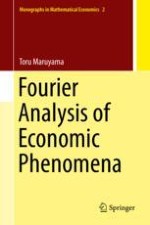2018 | OriginalPaper | Buchkapitel
9. Almost Periodic Functions and Weakly Stationary Stochastic Processes
verfasst von : Toru Maruyama
Erschienen in: Fourier Analysis of Economic Phenomena
Verlag: Springer Singapore
Aktivieren Sie unsere intelligente Suche, um passende Fachinhalte oder Patente zu finden.
Wählen Sie Textabschnitte aus um mit Künstlicher Intelligenz passenden Patente zu finden. powered by
Markieren Sie Textabschnitte, um KI-gestützt weitere passende Inhalte zu finden. powered by


